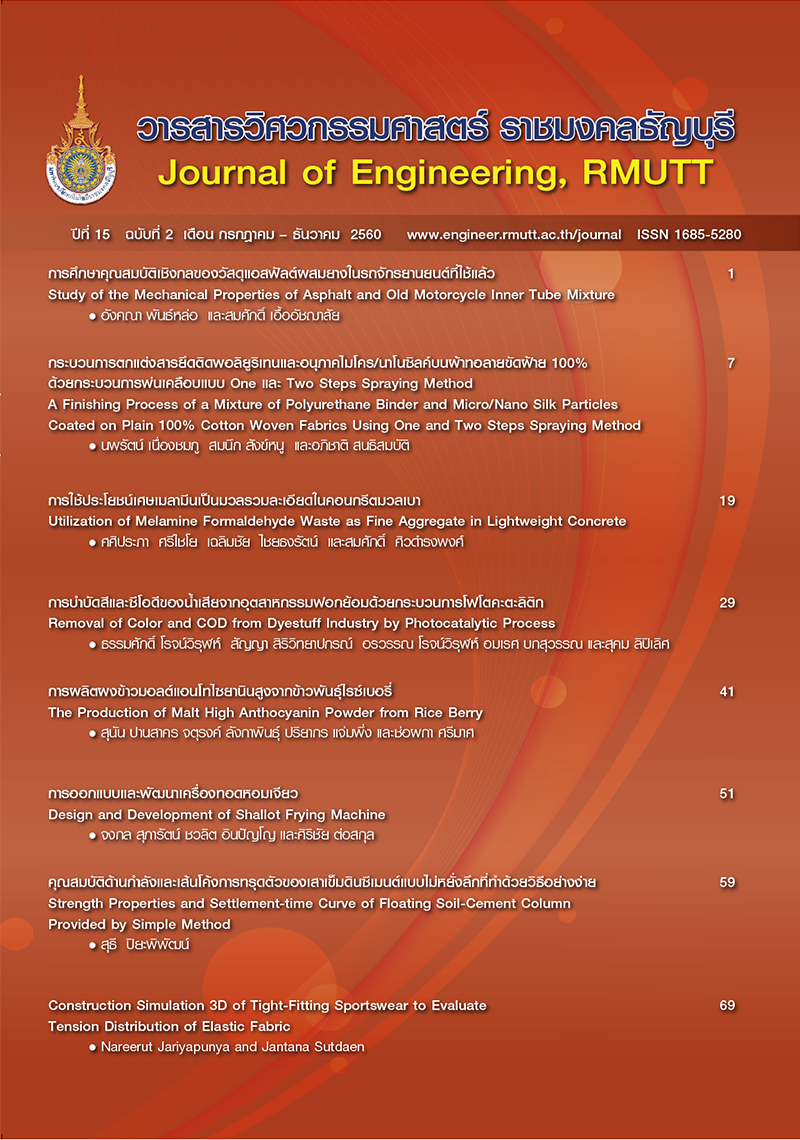A Finishing Process of a Mixture of Polyurethane Binder and Micro/Nano Silk Particles Coated on Plain 100% Cotton Woven Fabrics Using One and Two Steps Spraying Method
Main Article Content
Abstract
The aim of this research was to study the new finishing method (Spraying Method using a Spray Gun) which is different from the Dip-Nip-Dry Finishing Method that is widely used in the textile industries. One Step Spraying Method, the solutions were prepared by mixing 10% Polyurethane binder solution with Micro/Nano Silk solutions of the amount of 0.5, 1.0, 1.5, 2.0% respectively and the solutions were sprayed on the surface of plain 100% cotton woven fabrics, weighed the fabrics and then dried at 120oC for 120 seconds. The fabrics were put into a standard condition at textile testing laboratories. Two Steps Spraying Method, the solutions were prepared by mixing 10% Polyurethane binder solution, sprayed on the surface of the fabrics, weighed the fabrics. After the first spraying, the Micro/Nano Silk solutions of the amount of 0.5, 1.0, 1.5, 2.0% respectively were sprayed on each fabric, weighed the fabrics again and then dried at 120oC for 120 seconds. The fabrics were tested for the percentage weight loss after abrasion resistance (dry and wet conditions), after washing fastness (20 times). The fabrics were tested for wicking time and they were investigated the size and morphology of the particles. It was concluded that the abrasion resistance test results had weight loss percentage (-0.114% to -0.510%). Both methods gave the same wicking time (water permeability time). Nevertheless, it was found that the Two Steps Spraying Method fabrics showed less percentage weight loss after washing process than that from the One Step Spraying Method. From the SEM images, the fabrics from both
methods showed that the particles remained on the fabrics. It can be concluded that two steps spraying method may be used to finish the fabrics for spa purposes because the binder was firstly sprayed on the cloth. It might have possibilities to contact much more surface areas than that from the one step Spraying Method before spraying the Micro/Nano silk particles on top of the fabrics again.
Article Details
The manuscript, information, content, picture and so forth which were published on Frontiers in engineering innovation research has been a copyright of this journal only. There is not allow anyone or any organize to duplicate all content or some document for unethical publication.
References
Sonthisombat, A. 1993, M.Sc.Thesis, The University of Leeds, UK.
Sonthisombat, A. 1997, Ph.D.Thesis, The University of Leeds, UK.
อภิชาติ สนธิสมบัติ สมนึก สังข์หนู สิงห์โต สกุลเขมฤทัย ปิยะพงษ์ อัศวศุภฤกษ์ ชิโนทัย พรหมหิตาทร โครงการวิจัย “การผลิตอนุภาคนาโนเซริซิน และ ไฟโบรอิน เพื่อนำไปใช้ในการตกแต่งบนเสื้อผ้ากีฬา”
สนับสนุนทุนวิจัยโดยสถาบันพัฒนาอุตสาหกรรมสิ่งทอ ประจำปีงบประมาณ 2550 มหาวิทยาลัยเทคโนโลยีราชมงคลธัญบุรี ปทุมธานี หน้า 1-278.
พวงผกา คุ้มสีไว และ ยิ่งมณี ตระกูลพัว การประชุมหาดใหญ่วิชาการระดับชาติ ครั้งที่ 6 26 มิถุนายน 2558 มหาวิทยาลัยหาดใหญ่ หน้า 1524-1534.
อภิชาติ สนธิสมบัติ, 6 มกราคม 2558, กรรมวิธีการผลิตผงไหม (ไฟโบรอินและเซริซิน) เพื่อใช้ในงานด้านสิ่งทอ การแพทย์ และเครื่องสำอาง, ประเทศไทย เลขที่อนุสิทธิบัตร 9418.
Robson, R.M., Silk; Composition, Structure and Properties, in Handbook of Fiber Science and Technology, Vol. IV, Ed. By Lewin, M., and Pearce, E.M., Mercel Dekker Inc., New York, 1985, pp 647-700.
อภิชาติ สนธิสมบัติ, กระบวนการทางเคมีสิ่งทอ, คณะวิศวกรรมศาสตร์ สถาบันเทคโนโลยีราชมงคล, ปทุมธานี, 2545 หน้า 1-327.
ความหมายของการตกแต่งเชิงกล และเชิงเคมี [ออนไลน์] เข้าถึงได้จาก : http://www.ttcexpert.com/lesson4.html (29 มีนาคม 2560).
โปรแกรม SemAfore 5.2 [ออนไลน์] เข้าถึงได้จาก : http://semafore.software.informer.com/5.2/
(29 มีนาคม 2560).
Spray Gun [Online] Available : http://anestiwata.com/wp-content/uploads/2011/12/manual-catalog.pdf
(13 May 2017).
เทคนิคการพ่นสี [ออนไลน์] เข้าถึงได้จาก : https://goo.gl/uSWrfv (13 พฤษภาคม 2560).


